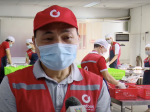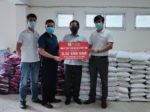For the purpose of detecting and isolating the Coronavirus SARS-CoV-2 living on the packaging of frozen food containers imported from Mainland China, employees involved in this work also need to be cautious and prevent the risk of infection. The Center for Food Safety has made a number of important recommendations to reduce the risk of COVID-19 infection for employees when processing frozen food:
Personal hygiene
Frozen food handlers need to keep in mind
- Check body temperature daily before work
- Stop engaging in food processing when you suspect or have an infectious disease, or if you have symptoms of illness such as: fever, respiratory illness, sudden loss of taste, diarrhea, vomiting, jaundice, sore throat and stomachache. Need to wear a mask and see a doctor promptly.
- When cough or sneeze should cover your mouth and nose with a tissue and throw the used tissue in the trash. Then wash your hands with soap and water. Need to take time off if you have respiratory symptoms.
- Have a good personal hygiene – wash hands often: after cleaning, after handling, after using the toilet, after touching public facilities such as handrails or doorknobs, before and after handling food, and before contacting with the mouth, nose, or eyes. Wash your hands with soap and water, rub them for at least 20 seconds. Then rinse with clean water and dry with disposable paper towels.
- Once your hands have been washed, do not touch the faucet directly (e.g. use a tissue to wrap the faucet before turning it off).
Personal protective clothing
- When handling frozen foods, staff should be equipped with masks, eye protection (such as face shields), gloves and special clothes.
- Once gloves are damaged, soiled or discarded can interrupt work process should be discarded. Gloves should be changed frequently, and hands should be thoroughly washed between glove changes. Do not touch your mouth, nose and eyes after wearing gloves.
Environmental sanitation
- Ensure the work environment is fully ventilated and the drainage function meets standard
- Increase regular cleaning and disinfection, by using 1:99 diluted bleaches (i.e., by mixing 1 portion of bleach to 99 portions of water) for some work areas, including: Kitchen, dining room, dishwasher, toilet (including faucet and toilet handle) and sitting area
- Processing tables, walls and utensils in the facility – Transport vehicles – Refrigerators and freezers – High contact surfaces (e.g., doorknobs, refrigerator/freezer handles, etc.)
- In addition to chlorine – based disinfectants (sodium hypochlorite), quaternary ammonium compounds (QUATS) can be used to disinfect food contact surfaces, containers, and trays. Alcohol-based disinfectants (ethanol, propan-2-ol, propan-1-ol) have been shown thatcan significantly reduce the infectivity of viruses such as SARS-CoV-2, at concentrations of 70 -80% with one minute exposure time.
- While hand washing is important for food workers, hand sanitizer can be used to disinfect food surfaces if needed.
- Mix 1 portionof bleach and 49 portions of water to dilute and use for areas contaminated with respiratory waste, vomit or feces.
Physical distancing
Food business owners should make it easy for employees who are sick or exhibiting symptoms of illness to receive prompt medical advice and testing for COVID-19 if recommended. They should also take the following measures to maintain distance between people handling frozen food during work:
- Ensure adequate physical distancing between food handlers during work or have appropriate physical barriers in place (e.g., partitions to reduce face-to-face contact between food handlers).
- Redesign workflow and workspace (e.g., set up desks only on one side of the production line to minimize face-to-face contact between food handlers; limit the number of food processingworkers; divide employees into different groups to reduce verbal conversations and cross-group contact, etc.)
- Display posters and add labels at work to remind food handlers of physical distancing. Set different working hours and flexible mealtimes for food handlers.



















